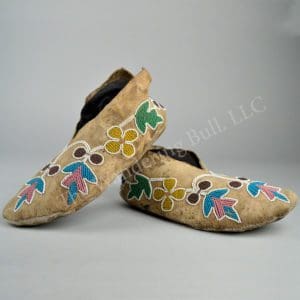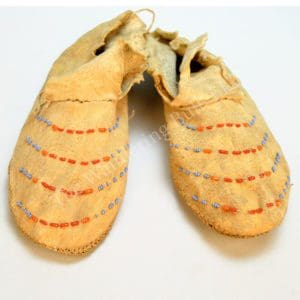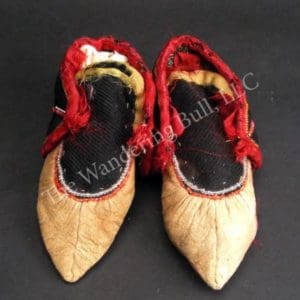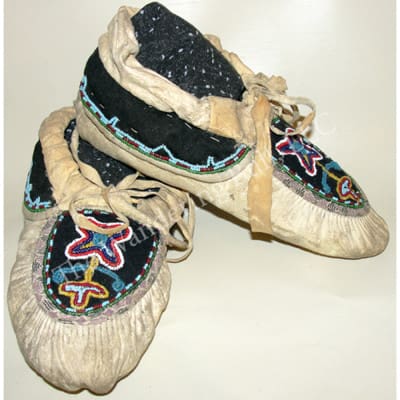
Identifying Antique Moccasins
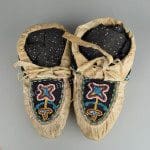

The moccasins themselves are constructed with Braintanned Deerskin. Native Americans tanned their own deerhides using the brain of the animal to soften the hide. After it was soaked and worked, it was smoked to preserve it. Until Europeans brought commercial tanning methods to North America, all animal leather was braintanned. The moccasins were sewn together with cotton thread instead of real animal sinew, so they were created in the historical period.
The vamp of the moccasins show a very fine ‘pucker’ or gathering of the leather. On the toe there are 10 ‘puckers’ per inch! This style of making moccasins was popular with Native Americans who lived in Northeastern North America. This style is not found on moccasins made by Native Americans in other parts of North America. The vamp of the moccasin was created with trade goods like wool, fabric and seed beads.
Historical Trade Beads
Native American crafters were very fond of glass beads. The colors that were popular in the 18th and 19th century were colors that can be seen on these moccasins, including Pony Trader Blu

The Bovis Bead Company in France continued to make beads in these “old time” colors until they closed in the late 20th century. Stocks of these beads are highly sought after by crafters making reproductions of clothing and accessories. The Wandering Bull, LLC offers several colors and sizes of these Reproduction Beads.
Unusual Features
A wool cuff was added to the moccasins. The cuff is backed with fabric which was rolled up to create a fabric edge. The lower edge of the wool on the cuff was decorated with seed beads. An unusual feature on this pair of Algonquin moccasins is the leather top of the cuff. The top of the leather was rolled down and sewn to the moccasin. This created a space to hold the lacing that was used to tighten the moccasins around the wearer’s feet.
Find More High Quality Native American Craftwork!
We are fortunate to have such a well preserved example of early 20th century craftwork at The Wandering Bull, LLC. These moccasins were worn, and not created as a tourist souvenir. Some of the beadwork has been repaired. Despite this, these Algonquin moccasins are in very good condition. They would make a fine addition to a beadwork or moccasin collection.
The Wandering Bull, LLC – Native American Craft store is proud to acquire and preserve artifacts like these moccasins for our customers. We are always looking for collections of unique items that you will not find anywhere else! Identifying the age and origin of One of a Kind items is a priority for us. Browse our collectibles section for more beautiful examples of One of a Kind craftwork, both antique and contemporary!

